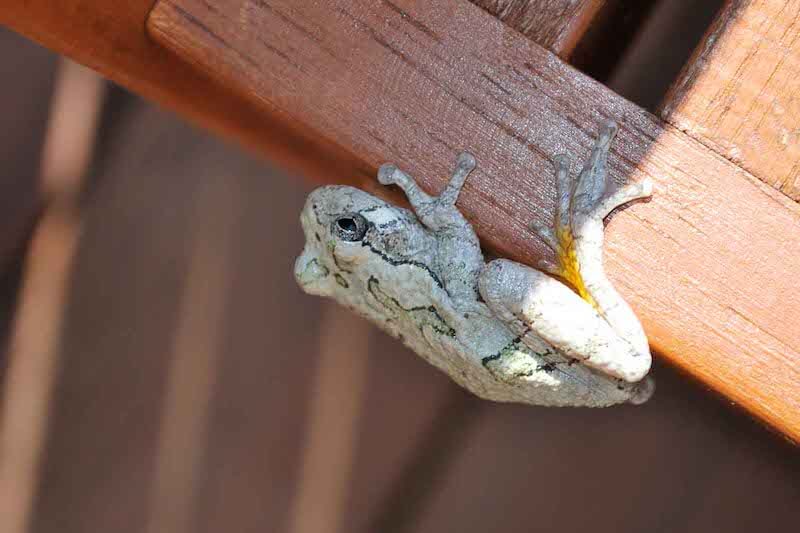Abundant and adaptable, tree frogs are known for their tree-climbing, wall climbing, jumping, and camouflaging capabilities. However, not all of them spend time in high trees, and you can often find these frogs on the ground and near water bodies. Georgia offers a wide range of habitats ideal for different tree frog species, including mountainous areas, wetlands, lakes, and a coastal plain. There are many species on to find out where you can find the 16 species of tree frogs in Georgia, including interesting facts about them.
16 tree frogs in Georgia
1. Northern cricket frog

Scientific name: Acris crepitans
Unlike most smooth-skinned tree frogs, the Northern cricket frog is small and warty, growing around 0.75 to 1.5 inches long. They are various shades of brown, green, and gray with brown to orange stripes, long limbs, and no toe pads. These frogs don’t climb as well as other tree frog species and aren’t found in high trees.
They are most common in northern Georgia, in the Piedmont and Mountainous regions, including the northern Coastal Plain area. They prefer moist habitats at the edges of lakes, ponds, and slow-moving streams.
2. Southern cricket frog
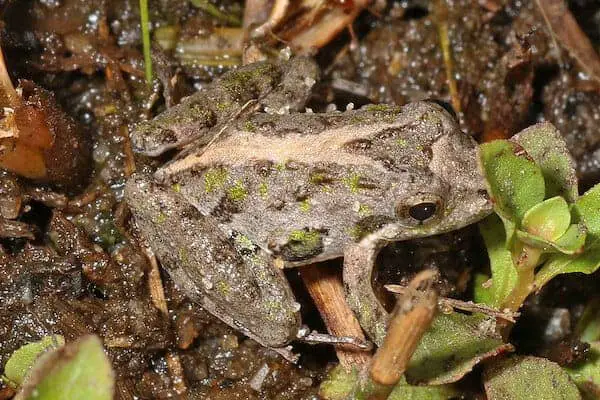
Scientific name: Acris gryllus
The southern cricket frog looks similar in appearance to the northern species. They are both small and warty with gray, green, or brown shades and stripes. However, the southern cricket frog’s stripes are straight edges with light borders instead of jagged edges.
Their call and range are other ways to distinguish the southern cricket frog. You can find them in southern Georgia’s Coastal Plain.
3. Barking Tree Frog
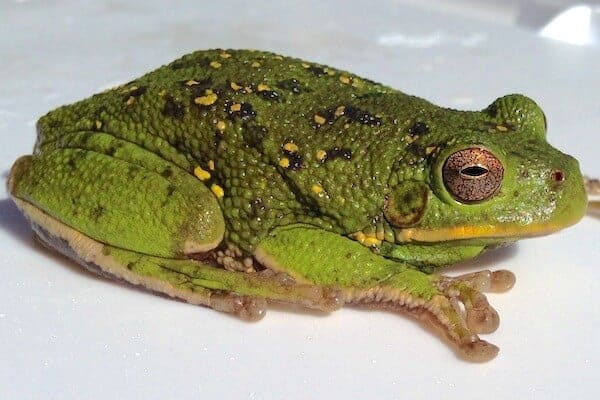
Scientific name: Hyla gratiosa
Barking tree frogs are the largest tree frog species in Georgia. They are heavy-bodied, average over 2 inches long, have granular skin, and are bright green with dark round spots and a white line on the lip.
They get their name from the explosive tonk or donk sound they repeat, sounding like barking dogs. You can find them living in high trees or breeding near fishless wetlands in the southeast Coastal Plains region.
4. Bird-voiced tree frog
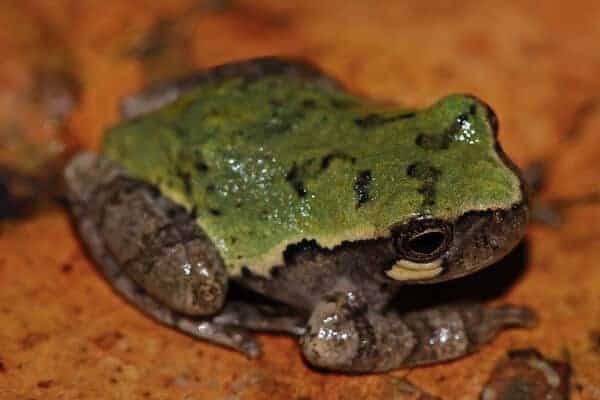
Scientific name: Hyla avivoca
Bird-voiced tree frogs are mottled gray or change to green or brownish depending on temperature or activity. They get their name from their breeding call that sounds like a series of bird-like, sharp whistles.
You can find them throughout central Georgia, especially in wooded swamplands and forested wetlands. They lay their eggs at the bottom of ponds or on submerged vegetation.
5. Cope’s gray tree frog
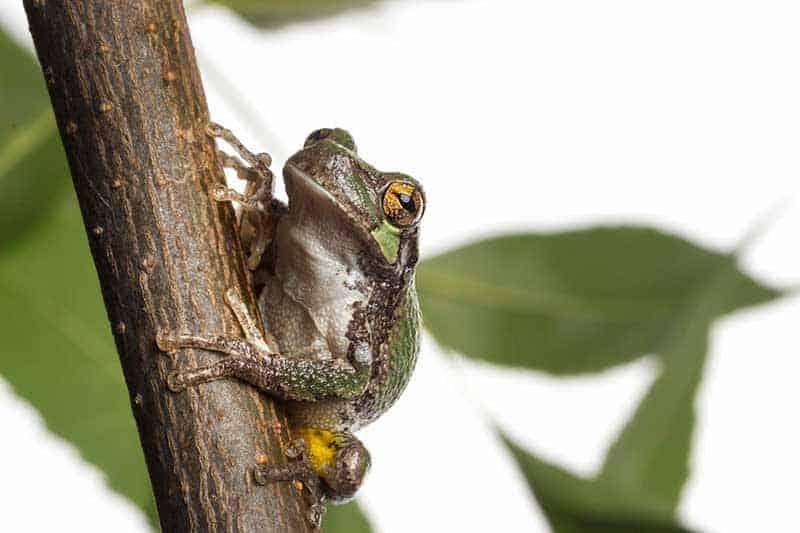
Scientific name: Hyla chrysoscelis
Cope’s gray tree frogs are typically mottled gray with bright orange or yellow on their inner thigh. However, their color ranges to light green depending on their environment. They are another fairly large tree frog, growing around 1.25 to 2 inches. Their breeding call is a musical trill.
They hunt at night and spend most of their days hiding in secluded areas like tree holes. Throughout Georgia, you can find them in various wooded habitats but most commonly in mature deciduous forests.
6. Green tree frog

Scientific name: Hyla cinerea
As their name suggests, the green tree frog is green with white or yellow stripes along the side of their body. They grow around 1.25 to 2.25 inches and have long limbs and digits. Their call is a loud reenk or quank sound.
These frogs live mostly in trees but also commonly wander near patio and porch lights to catch insects during wet, warm weather. You can find them in the Coastal Plain region of Georgia.
7. Pine woods tree frog

Scientific name: Hyla femoralis
Nicknamed the morse-code frog, pine woods tree frogs make an irregular chattering call. They are brownish with yellow, orange, or whitish spots on the rear of their thigh and have slightly webbed toes.
In Georgia, they live in most of the Coastal Plain. They breed in shallow wetlands, including ditches, marshes, and swamps. They overwinter under loose bark and decaying logs.
8. Squirrel tree frog

Scientific name: Hyla squirella
The squirrel tree frog’s color ranges from green and yellowish to brown. They can be plain or spotted and are around 1 to 1.5 inches long.
These frogs are mostly in the Coastal Plain region of Georgia. They live in trees, bushes, and vines in wetland areas like swamps, marshes, and edges of streams or lakes. You can also find them in gardens, including under logs.
9. Little grass frog
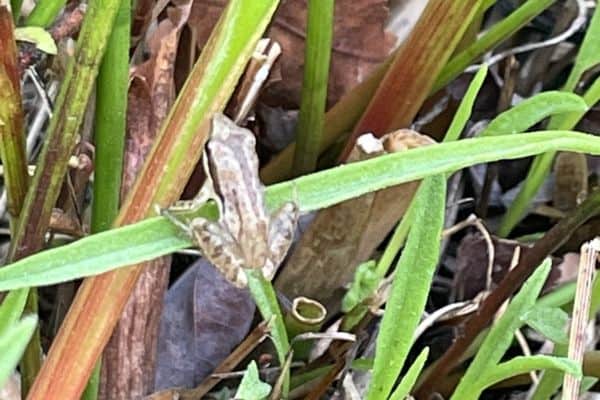
Scientific name: Pseudacris ocularis or Limnaoedus ocularis
Little grass frogs are the smallest North American frog species. They grow up to 0.69 inches long and have a reddish to brown ground color with a dark stripe from their eyes down their sides.
Because of their size, they hang out in lower vegetation and can be found in the Coastal Plain regions. They breed during any month throughout the year, but the peak season is in late spring.
10. Spring peeper

Scientific name: Pseudacris crucifer
Spring peepers are distinguishable by the X mark on their back, small toe pads, and gray to brown coloring. Growing between 0.98 and 1.5 inches, they are rarely seen, but you can hear their high-pitched whistle call during the evenings and nights.
You can find them throughout Georgia, especially in areas with standing water surrounded by small trees or shrubs. They are also active in wooded areas after heavy rains.
11. Mountain chorus frog
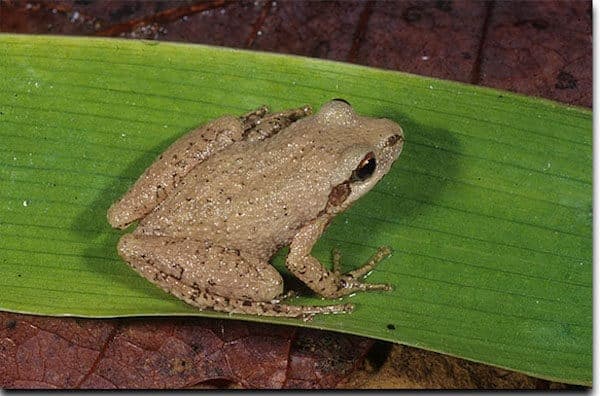
Scientific name: Pseudacris brachyphona
Mountain chorus frogs can also have an X pattern on their backs. However, unlike the spring peeper they also have a dark triangle between the eyes. These frogs are gray to olive and grow between 1 to 1.5 inches long.
You can only find this species in a small area of the north Georgia Mountains. They live in forested habitats and woodlands at 3,500 feet or higher elevations.
12. Brimley’s chorus frog
Scientific name: Pseudacris brimleyi
Although their coloring is varied, the Brimley’s chorus frog is typically tan with three dorsal brown stripes. Their average length is 1 to 1.3 inches, and they make a short, raspy trill.
In Georgia, you can find them in a small section of the northeastern Coastal Plain. They live by rivers, swamps, marshes, ponds, canals, and ditches.
13. Southern chorus frog

Scientific name: Pseudacris nigrita
The southern chorus frog is typically brown with numerous black markings and a pale white line on the upper lip. They are the darkest of the chorus frog species in the southeastern states.
In Georgia, their range is limited to the Coastal Plains area, especially near shallow water bodies. You can hear them singing their rasping, mechanical trill day and night. Their sound can resemble a ratchet-type wrench.
14. Upland chorus frog

Scientific name: Pseudacris feriarum
The upland chorus frog is brown or grey with a dark stripe running through each eye and a light line across their upper lip. They grow between 0.75 and 1.4 inches long and can be distinguished by their call, which is a smooth and fast crreeek that resembles fingers running over comb teeth.
You can find them in the Georgia Mountains and Piedmont regions, with a very small, isolated population in the southeast along the coast. They live in woodlands, wetlands, grassy areas, and bogs.
15. Ornate chorus frog
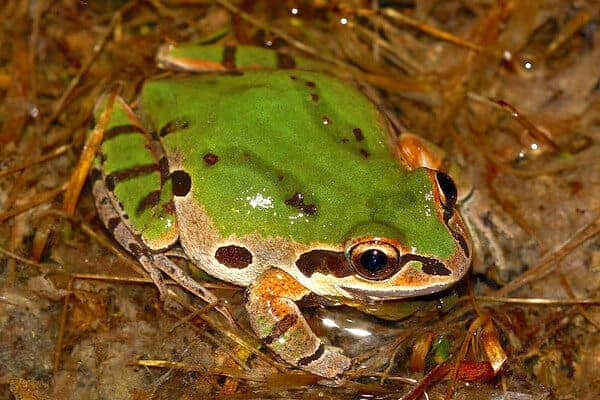
Scientific name: Pseudacris ornata
Ornate chorus frogs have small round toe tips and grow between 1 to 1.5 inches long. They have green, gray, and reddish-brown color phases and a black stripe across their eyes. Their call is a metallic and sharp repeated “tink” sound.
They live in the Coastal Plain region of Georgia in various wooded habitats and breed by small water bodies, including ditches, ponds, and flooded meadows. As a nocturnal frog, you can most commonly see them active on rainy winter nights.
16. Collinses’ mountain chorus frog
Scientific name: Pseudacris collinsorum
The Collinses’ mountain chorus frog was formerly considered a species of mountain chorus frog but was described as a distinct species in 2020. Although they share similar dorsal patterns, the Collinses’ mountain chorus frog’s calls are a faster pulse rate.
You can find them in northern Georgia, where they prefer drier or more pine-dominated, hilly habitats. They commonly live in elevations between 330 to 1,050 feet above sea level.
